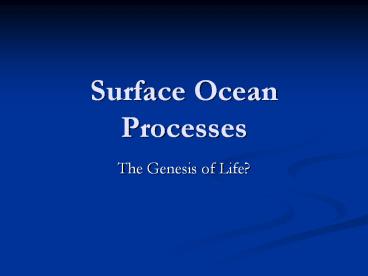Surface Ocean Processes PowerPoint PPT Presentation
Title: Surface Ocean Processes
1
Surface Ocean Processes
- The Genesis of Life?
2
Step 1 Creating Amino Acids
- The first step in the emergence of life would
require simple organic compounds that are the
building blocks of life. The 1953 Miller-Urey
experiment in showed some of these building
blocks could be easily formed in a mixture of
water, methane and ammonia when this mixture was
exposed to an energy source
NH3 2CH4 2H2O energy ? C2H5O2N 5H2
3
Glycine looses mixed in the ocean
Right Hand Side H is looking to attach to
something else as is the reactive H atom
4
Dilute Monomers
- If the mixture of these monomers (single carbon
atoms) is too dilute in the oceans the entire
process will fail. - This next step must be taken
5
Polymer Formation
- First step towards cells
- Note that Glycine is also found in the tails of
Comets ? did comet delivery seed the earth with
building blocks of life? - Mechanisms that concentrate the monomers would
aid in polymer formation
6
Clay Theory
- The only practical mechanism for concentration is
evaporation that is driven by some agent. for
evaporation. In this case, there are two clear
possibilities - heat the surface water
- evaporate the surface water from small
concentrations of ocean water. - Inland tidal pool could evaporate under the
intense sun in a couple of weeks or so. The tidal
mud would be come highly concentrated in monomers
that were originally in the ocean. The silicate
surfaces that compose this mud are known to be
good catalysts for polymer formation. - Four billion years ago the moon was substantially
closer to the Earth than it is now. That means
that tides of a few thousand feet high were not
that unusual! Those large tides could have easily
formed relatively large inland, shallow lakes,
which are prone to rapid evaporation so that the
monomers would settle into the clays that formed
the lake bottom.
7
Deep Sea Thermal Concentration
- Experiments starting in 1997 showed that amino
acids and peptides could form in the presence of
carbon monoxide and hydrogen sulfide with iron
sulfide and nickel sulfide as catalysts under
conditions of high temperature and pressure, such
as those found in a deep sea thermal vent. - The successful experiments required temperatures
of about 100 C and moderate pressures, although
one stage required 250 C and a pressure
equivalent to that found under 7 kilometers of
rock. These conditions do occur and therefore
hydrothermal facilitation of protein synthesis
(e.g. polymer formation) could well have occurred
in that environment. - In fact, this environment is more natural place
for this chemistry to occur and perhaps Step 2 is
entirely driven by this deep sea process and
nothing relevant is happening on the surface.
Over time this formed polymers could drift up to
the surface. Immersion in a liquid medium is very
important for further processes to occur since
the liquid medium both protects these large
molecules from disruption by ultraviolet light
(remember, there is no ozone layer yet) and it
serves as a transport and interaction medium.
8
Step 3 Discovering a Genetic Code
- Big Question
We dont know but there are plenty of ideas
9
DNA Formation
- In our framework, it is now useful to think of
the next set of steps in terms of the idea of
evolutionary advantage. For instance, its clear
that those polymers that can reproduce themselves
have a strong evolutionary advantage over those
that can't because those that can't die and those
that can live. - Organic polymers in high concentration can
separate out from the liquid medium as individual
droplets. These may be the first proto-cells - Long chain moleules (e.g. peptides) can
potentially act as a primitive membrane for that
proto-cell to control the flow of
nutrients/proteins to the proto-cell. - This exchange process continues, by Trial and
Error until the "right" combination is achieved
(e.g. DNA).
10
Time
- The fossil record shows that the first primitive
cells/bacteria capable of reproduction, known as
blue-green algae appear at least 2.8 BYA with
some good evidence for formations as old as 3.5
BY. In this sense we know that it took at least
one billion years to evolve from atmospheric
chemistry to blue green algae via the oceanic
pathway. Perhaps then, all you need is time and a
reasonable stable environment (like the oceans)
to exist for a billion years or so.
11
Multiplying Populations and the Need for
Resources
- Eat each other? Fermentation process is
inefficient - Process another element H2S from volcanoes,
metabolize the sulfur ? anaerobic photosynthesis
which produces glucose - Problem not enough H2S to sustain growing
population
12
Aerobic Photosynthesis
- Substitute H20 for H2S ? requires 1/3 more energy
so use UV photons at ocean surface as the energy
input. Bacteria have to evolve this capability - There is no shortage of H20 so bacteria that
develop this capability evolutionary advantage. - The fossil record indicates that it takes about
500 million years from the appearance of the
first blue-green algae engaging in anaerobic
photosynthesis (cyno) bacteria that are able to
use water producing oxygen as a waste product..

